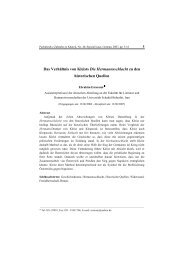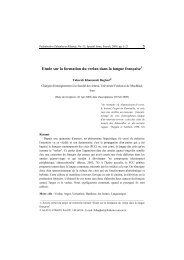Phonological Metathesis in Persian: Synchronic, Diachronic, and the ...
Phonological Metathesis in Persian: Synchronic, Diachronic, and the ...
Phonological Metathesis in Persian: Synchronic, Diachronic, and the ...
You also want an ePaper? Increase the reach of your titles
YUMPU automatically turns print PDFs into web optimized ePapers that Google loves.
32 Pazhuhesh-e Zabanha-ye Khareji, No. 56, Spr<strong>in</strong>g 2010<br />
participated <strong>in</strong> this study. Their teach<strong>in</strong>g experience ranged from 1 to 25 years<br />
(mean=3.65, SD=3.33). Follow<strong>in</strong>g Tschannen-Moran <strong>and</strong> Hoy (2007) <strong>and</strong> Chan<br />
(2008), we chose three years of teach<strong>in</strong>g experience as <strong>the</strong> cut-off po<strong>in</strong>t for divid<strong>in</strong>g<br />
novice <strong>and</strong> experienced teachers. As a result, 253 of <strong>the</strong> participants were classified<br />
as novice <strong>and</strong> <strong>the</strong> rest (194 teachers) were categorized as experienced. From among<br />
this population, those teachers who had a Bachelor of Art (BA) <strong>in</strong> English-related<br />
majors (i.e., English translation <strong>and</strong> English literature) or post graduate degrees <strong>in</strong><br />
Teach<strong>in</strong>g English as a Foreign Language (TEFL) were considered to have degrees<br />
which were relevant to English teach<strong>in</strong>g. O<strong>the</strong>r participants were considered as<br />
hold<strong>in</strong>g irrelevant degrees. Based on this criterion, 202 teachers had relevant <strong>and</strong><br />
245 had irrelevant academic degrees.<br />
Instrument<br />
Teacher self-efficacy scale (TSES) developed by Tschannen-Moran <strong>and</strong> Hoy<br />
(2001) was used as a criterion to assess teachers’ self-efficacy beliefs s<strong>in</strong>ce its<br />
validity has been proved <strong>in</strong> different contexts (Klassen et al., 2009). This <strong>in</strong>strument<br />
consists of 24 questions answered on a 9 po<strong>in</strong>t likert scale rang<strong>in</strong>g from 1-noth<strong>in</strong>g to<br />
9-a great deal. TSES <strong>in</strong>cludes three subcomponents (efficacy for student<br />
engagement, efficacy for <strong>in</strong>structional strategies, <strong>and</strong> efficacy for classroom<br />
management) each of which is measured through eight questions. Accord<strong>in</strong>g to<br />
Tschannen-Moran <strong>and</strong> Hoy’s (2001) guidel<strong>in</strong>es, <strong>the</strong> <strong>in</strong>strument can be used <strong>in</strong> two<br />
different ways: first, by calculat<strong>in</strong>g <strong>the</strong> means of participants’ answers to all 24<br />
questions. This score, which ranges from 1 to 9, is called global efficacy; second, by<br />
calculat<strong>in</strong>g <strong>the</strong> means of <strong>the</strong> answers for each of <strong>the</strong> three subcomponents separately<br />
which yields three scores for each person rang<strong>in</strong>g form 1 to 9; <strong>the</strong> higher <strong>the</strong> score a<br />
participant ga<strong>in</strong>s, <strong>the</strong> higher his/her self-efficacy beliefs.<br />
Procedure<br />
In order to control contextual factors as much as possible, <strong>the</strong> participants were<br />
chosen from a s<strong>in</strong>gle language <strong>in</strong>stitute <strong>in</strong> Tehran. Five hundred teachers work<strong>in</strong>g <strong>in</strong>






